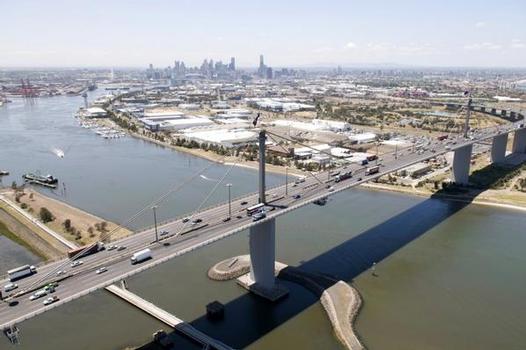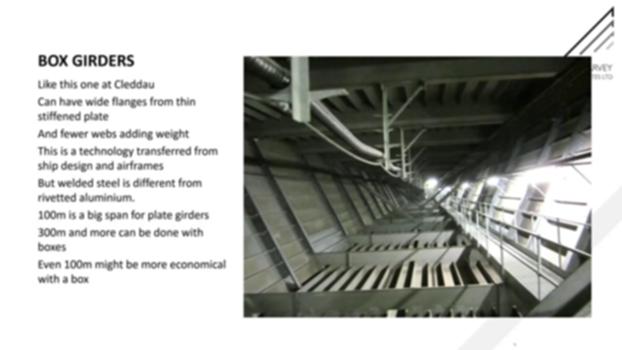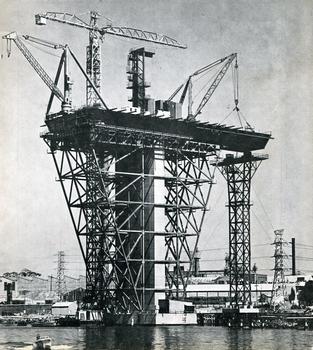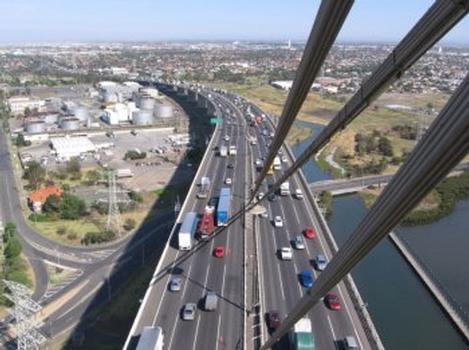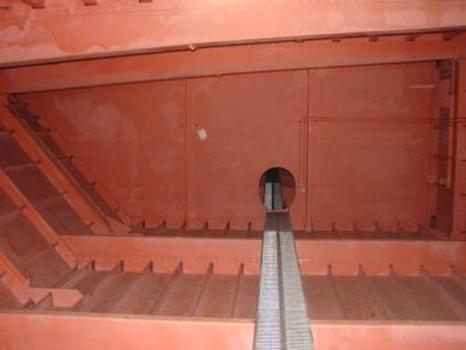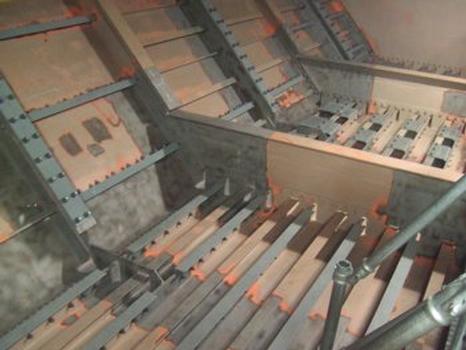General Information
Project Type
| Structure: |
Three-span cable-stayed bridge |
|---|---|
| Function / usage: |
Road bridge |
| Material: |
Steel bridge |
Location
| Location: |
Melbourne, Victoria, Australia |
|---|---|
| Crosses: |
|
| Coordinates: | 37° 49' 45.84" S 144° 53' 52.80" E |
Technical Information
Dimensions
| main span | 336 m | |
| width | max. 37.3 m | |
| total length | 2582.6 m | |
| clearance | min. 53.7 m | |
| pylon | pylon height | 102 m |
Cost
| cost of construction | Australian dollar 202 000 000 |
Materials
| deck of main bridge |
steel
|
|---|---|
| deck of approach viaducts |
concrete
|
Case Studies and Applied Products
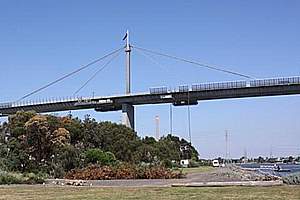
West Gate Bridge Upgrade
West Gate Bridge crosses the mouth of the Yarra River in Melbourne, Australia. Its 2.6km overall length comprises two concrete box girder high level approach viaducts either side of an 850m long, 5-span cable stayed steel box girder bridge with a 336m main span. The ... [more]
Chronology
| 15 October 1970 | Steel span collapses during construction killing 35. |
|---|---|
| 15 November 1978 | The bridge is opened. |
Excerpt from Wikipedia
The West Gate Bridge is a steel box girder cable-stayed bridge in Melbourne, Victoria, Australia. It spans the Yarra River, just north of its mouth into Port Phillip, and is a vital link between the inner city (CBD) and Melbourne's western suburbs; with the industrial suburbs in the west and with the city of Geelong, 80 kilometres (50 mi) to the south-west. It is one of the busiest road corridors in Australia.
The main river span is 336 metres (1,102 ft) in length, and the height above the water is 58 metres (190 ft). The total length of the bridge is 2,582.6 metres (8,473 ft). It is the fifth-longest in Australia behind the 3.2 kilometres (2.0 mi) Macleay River Bridge and the Houghton Highway along with its twin the Ted Smout Memorial Bridge, with the longest being Melbourne’s Bolte Bridge at 5 kilometres (3.1 mi). It is twice as long as the Sydney Harbour Bridge, and is one of the highest road decks in Australia, clearing the water at 58 metres (190 ft), with the Sydney Harbour Bridge clearing the water at 49 metres (161 ft).
The bridge passes over Westgate Park, a large environmental and recreational reserve created during the bridge's construction. The bridge carries up to 200,000 vehicles per day.
Transportation
Motor vehicles
The West Gate Bridge carries five lanes of motor vehicle traffic in each direction, therefore a 10 lane dual-carriageway freeway bridge.
The freeway corridor (including the bridge itself) carries a very high volume and occupancy of traffic, between 180,000 - 200,000 cars / trucks / motorcycles use it per day, according to VicRoads. This makes the West Gate Bridge and West Gate Freeway one of the busiest road corridors in Australia.
However, being the only main direct link between Melbourne's CBD and the West, it is frequently congested during the morning and afternoon peaks (despite having 5 lanes in each direction) and is constantly busy 24/7, due to the number and type of vehicles coming in and out of Melbourne (i.e.) Port of Melbourne.
The bridge was originally tolled. Tolls were abolished in 1985, because drivers were using other routes to avoid the toll.
Cycling and the Westgate
Cyclists are prohibited from using the bridge except for special bicycle events, notably the MS Summer cycle, which is a fundraising event for multiple sclerosis, and the Around the bay in a day Bicycle Network event that raises money for The Smith Family charity. The Westgate Punt is a foot ferry that runs directly below the bridge, taking cyclists and pedestrians across the Yarra between a jetty at Fishermans Bend near Westgate Park – Bay Trail and a jetty adjacent to Scienceworks Museum – Hobsons Bay Coastal Trail. It operates on demand, from Monday to Friday in morning and evening peaks, and on weekends and public holidays from 10:00 am to 5:00 pm
History
Collapse
Two years into construction of the bridge, at 11:50 am on 15 October 1970, the 112 metres (367 ft) span between piers 10 and 11 collapsed and fell 50 metres (160 ft) to the ground and water below. Thirty-five construction workers were killed and 18 injured, making it Australia's worst industrial accident. Many of those who perished were on lunch break beneath the structure in workers' huts, which were crushed by the falling span. Others were working on and inside the span when it fell. The whole 2,000-tonne (4,400,000 lb) mass plummeted into the Yarra River mud with an explosion of gas, dust and mangled metal that shook buildings hundreds of metres away. Nearby houses were spattered with flying mud. The roar of the impact, the explosion, and the fire that followed, could be clearly heard over 20 kilometres (12 mi) away. On the following morning, 16 October, Sir Henry Bolte (Premier of Victoria) announced that a Royal Commission would be set up immediately to look into the cause of the disaster. The Prime Minister, John Gorton, said: "I am sure the whole of Australia is shocked and saddened by the serious accident at West Gate Bridge. Please extend my deepest sympathy to all those families to whom this tragic event has brought such grief."
Cause
A Royal Commission into the collapse was established, which concluded on 14 July 1971. It attributed the failure of the bridge to two causes: the structural design by designers Freeman Fox & Partners and an unusual method of construction by World Services and Construction, the original contractors of the project.
On the day of the collapse, there was a difference in camber of 11.4 centimetres (4.5 in) between two half-girders at the west end of the span which needed to be joined. It was proposed that the higher one be weighted down with 10 concrete blocks, each weighing 8 t (8.8 short tons), which were located on site. The weight of these blocks caused the span to buckle, which was a sign of structural failure. The longitudinal joining of the half girders was partially complete when orders came through to remove the buckle. As the bolts were removed, the bridge snapped back and the span collapsed.
Collapse memorials
Six twisted fragments of the collapsed bridge can be found adorning the gardens in the engineering faculty of Monash University, Clayton campus. It is said by students that they are to remind engineers of the consequences of their errors. Monash University acquired these when asked to participate in the investigation of the collapse.
Commemorations have been held on 15 October every year since the collapse. A West Gate Bridge Memorial Park to workers who lost their lives is located near the bridge. It opened on the 34th anniversary of the collapse, 15 October 2004. It includes the existing West Gate Bridge Memorial and Sculpture, and the memorial for six who died in the Spotswood Yarra Sewer Tunnel collapse of 12 April 1895 (Good Friday).
Completion
Construction resumed in 1972, with the bridge being completed in 1978. After 10 years of construction, the bridge, a part of the larger West Gate Freeway, cost $202 million.
Speed cameras were erected on the bridge in 2004, but were not activated until September 2005, because of issues with a similar camera on the Western Ring Road. However these speed cameras were switched off in 2005, and currently remain disabled, as the sway of the bridge prevents secondary verification of the alleged speed against a fixed point. In 2006 the State Government spent $1.3 million on erecting railway style boom barriers at each entrance to the bridge to block traffic in the event of a terrorist attack. In March 2007 the State Government announced that two flagpoles would be erected atop the main bridge pylons, to fly the Australian and Victorian flags, each being 10 by 5 metres (33 by 16 ft) in size and 135 metres (443 ft) above sea level. Costing $350,000 to install and $15,000 a year to maintain, the flags were unfurled on 24 September 2008.
On 5 August 2007 it was reported that the Victorian Government was planning a $240 million project to identify and eliminate structural weaknesses in the bridge, with specific concerns including crash barriers, cracking, corrosion and potential buckling. News of the work was prompted by the collapse of the I-35W Mississippi River bridge in Minneapolis, Minnesota, United States. Experts were reported as saying the West Gate was initially designed to carry loads of 25 tonnes (55,000 lb) but now carried B-double trucks weighing up to 68 tonnes (150,000 lb). The bridge was built to carry 40,000 vehicles a day, but volumes are now more than four times the original amount, approximately 160,000 vehicles on an average day.
Expansion
On 17 May 2006, the State Government as part of their Meeting Our Transport Challenges plan announced plans to change traffic flow in peak periods on the West Gate Bridge and approaches to it, using a reversible lane to provide five traffic lanes in the peak direction, opposing traffic having three lanes. This was to be done using overhead signals and barriers and the State Government allocated funds to this project in its 2006–2007 state budget, but the works were never carried out.
In 2008 the expansion plans were revised as part of the Victorian Transport Plan, when it was announced that the bridge would be widened to 5 lanes in each direction, the space being gained by narrowing the existing traffic lanes and closing the emergency lanes, in a move criticised by Victorian fire, police and ambulance unions. Overhead gantries would be used to direct traffic out of lanes when breakdowns and accidents occur. Costed at $240 million, each lane would be 3.1 metres (10 ft) wide, by comparison lanes on the Sydney Harbour Bridge have a width of 2.8 metres (9.2 ft). Roads Minister Tim Pallas claimed that the plan would allow the bridge to carry 50 percent more vehicles, while reducing crashes by 20 percent. Structural analysis work on the bridge concluded in early 2009 and was completed over a 14-month period. Works to strengthen the bridge commenced in the first half of 2009, with the entire strengthening project scheduled for completion in 2011.
On 22 June 2011 all five lanes were finally opened to the public in both directions, with the completion of the required strengthening works. The full cost was $347 million, $107 million more than VicRoads had originally planned, but included considerable additional scope of works. This cost increase was after the deletion of $20 million architectural lighting originally included in the scope of the works. The engineers for the strengthening project, Flint & Neill and Sinclair Knight Merz, won the 2012 Institution of Structural Engineers Supreme Award for structural engineering for the project.
West Gate Bridge Flag
On 11 March 2014 a 10 metres (33 ft) artist-designed flag was raised on the western side of the bridge as part of the 'Melbourne Now' exhibition, ‘On Top of the World: Flags for Melbourne’. The flag was a collaborative design between four contributing artists involved in the show who shared an affinity with the bridge. It’s a reference to 1803 maritime communications by Rear Admiral Home Riggs Popham, the symbol on the flag meaning ‘I can spare what you asked for’. The flag was flown until the end of the 'Melbourne Now' show on 25 March 2014. Artists Brook Andrew, Helen Johnson, Kate Daw and Jon Campbell were collaborating with Stewart Russell as curator.
Future
Strong growth in suburbs along the route, and increased freight through the Port of Melbourne, means that the corridor is experiencing traffic congestion during peak periods, is vulnerable to short term interruptions and is rapidly approaching capacity. Proposals to abate congestion by allowing more traffic have included bridge widening, a tunnel underneath the river, or adding a second deck to the bridge. Many such plans have come under fire from community groups such as the Public Transport Users Association and Environment Victoria advocating investment in alternative forms of transport.
A private sector report made public in February 2006 suggested building a companion tunnel to the West Gate Bridge under the Yarra River. Made up of three separate bores to carry traffic in either direction and a freight rail line, the portals would have been north of Williamstown Road in Port Melbourne, and between Blackshaws and Melbourne roads in Altona North.
The State Government also assessed options for the development of another east-west link in 2008. Sir Rod Eddington, former CEO of British Airways and Chairman of the Victorian Major Events Company, will head the assessment of the future East-West connections and recommend the best way forward for public transport, road and freight travel for the entire Monash-West Gate corridor. By December 2008 the State Government announced it was planning for such a link, anticipated to be a three kilometre road tunnel under Footscray and the Maribyrnong River. Linking Dynon and Footscray Roads in the Port of Melbourne precinct to Geelong Road in West Footscray, now known as the East-West road connection its cost is estimated at more than $2.5 billion.
Incidents
Suicide location
Police data show up to one suicide occurs every three weeks at the West Gate Bridge. A 2004 coroner's report recommended anti-suicide fencing or barriers be erected on the bridge to deter people from attempting to end their lives. In 2008, the bodies of a mother in her late 20s and her 18-month-old baby were found on the river bank below the West Gate Bridge, prompting further calls to erect a suicide barrier.
Those who argue for a suicide barrier claim that most of those who jump from the West Gate Bridge do so through impulse and that police officers who try to save those who try to jump are putting their own lives in danger. There are multiple incidents of police officers dangling off the side of the bridge while holding onto would-be jumpers. A 2000 Royal Melbourne Hospital study on people who jumped from the bridge found at least 62 cases between 1991 and 1998. Seven people survived the 58-metre (190 ft) fall. 74 percent of those who jumped from the bridge were male, with an average age of 33. More than 70 percent were suffering from mental illness. Of those who jumped off the West Gate Bridge, 31 percent fell on land. Some of those who landed in water drowned afterwards.
Darcey Freeman incident
In January 2009 a Melbourne girl, Darcey Freeman, aged 4, was thrown off the bridge by her father and later died in hospital. In April 2011, Arthur Freeman was found guilty of murder and sentenced to life in prison. Following the incident, a temporary suicide barrier of concrete crash barriers topped with a welded mesh fence was erected starting in February. By June, it had been claimed that the fence had prevented two suicides. A permanent barrier was later installed along the length of the bridge. The barriers are costed at $20 million.
Text imported from Wikipedia article "West Gate Bridge" and modified on 22 July 2019 under the CC-BY-SA 3.0 license.
Participants
- Freeman Fox & Partners (main bridge)
- Maunsell & Partners (approach viaducts)
- Oscar G. Meyer (engineer)
- Hans Grassl (expert)
- Hans G. Wolfram (expert)
- Karlheinz Roik (expert)
- Robert G. Baker (expert)
Relevant Web Sites
Relevant Publications
- (2009): Bridge-specific Assessment Techniques for the Strengthening and Refurbishment of the West Gate Bridge, Melbourne. Presented at: IABSE Symposium: Sustainable Infrastructure - Environment Friendly, Safe and Resource Efficient, Bangkok, Thailand, 9-11 September 2009, pp. 47-54.
- (1974): Design Modifications to West Gate Bridge, Melbourne. In: Australian Civil Engineering Transactions [IEAust], v. 15, n. 2 ( 1974).
- (1990): Les grands ponts du monde: Hors d'Europe. Brissaud, Poitiers (France), pp. 290.
- Humber Bridge statistics, West Gate Bridge statistics. Presented at: 11th IABSE Congress, Vienna, Austria, 31 August - 5 September 1980, pp. 807-808.
- (2014): Management of fatigue cracking: West Gate Bridge, Melbourne. In: Proceedings of the Institution of Civil Engineers - Bridge Engineering, v. 167, n. 3 (September 2014), pp. 193-201.
- About this
data sheet - Structure-ID
20002441 - Published on:
30/11/2001 - Last updated on:
05/02/2016

